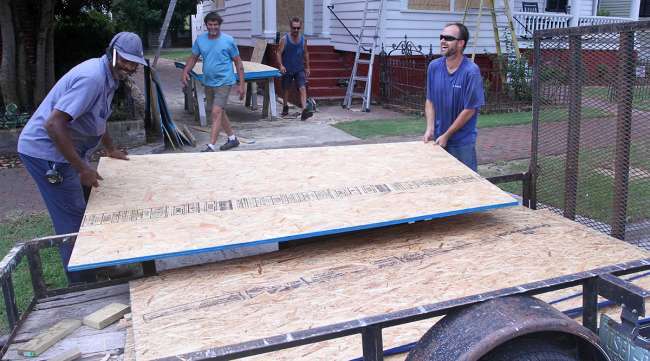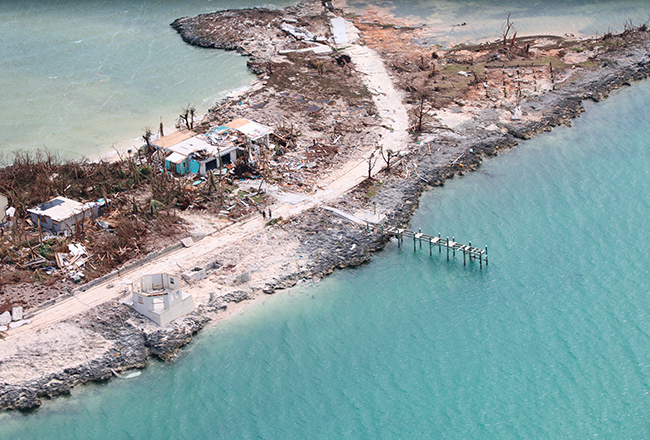Hurricane Dorian, Back to a Category 3, Creeps Up East Coast

[Stay on top of transportation news: Get TTNews in your inbox.]
CHARLESTON, S.C. — Hurricane Dorian, back to a Category 3 storm, began raking the Southeast U.S. seaboard late Sept. 4, threatening to inundate low-lying coasts from Georgia to southwest Virginia with a dangerous storm surge after its deadly mauling of the Bahamas.
Dorian had crashed into the island nation as its strongest hurricane on record, leaving widespread devastation and at least 20 people dead. But it weakened substantially in the days since, dropping from a Category 5 to a Category 2 storm before increasing again. Dorian still boasted dangerously high winds of 115 mph as it churned north toward the Carolinas while pushing crashing ocean waves onshore.
More than 1,500 people sought refuge in 28 shelters in South Carolina, where sheets of rain began falling late Sept. 4 in the historic port city of Charleston, located on a peninsula prone to flooding. As Dorian crept dangerously closer, winds picked up, sending rain sheets sideways. Thunder boomed in the night sky and power flickered on and off in places.
Though weakened, Dorian remained a force to be reckoned with, its swirling circle of winds and rain wrapped around a large, gaping eye visible on photos taken from space. At 11 p.m. EDT Sept. 4, the distinct eye of the hurricane churned about 105 miles south of Charleston, moving north at 7 mph off the coast.
In Charleston’s downtown, stores and restaurants were boarded up with wood and corrugated metal and about 830,000 people were under mandatory evacuation orders on the South Carolina coast.
Hundreds of thousands also were ordered off the Georgia coast. A flood chart posted by the National Weather Service projected a combined high tide and storm surge around Charleston Harbor of 10.3 feet; the record, 12.5 feet, was set by Hugo in 1989.
Georgia’s coastal islands were also at risk, Gov. Brian Kemp said Sept. 4, adding, “We are very worried, especially about the barrier islands getting cut off.”
The approach of Dorian has left the cobblestone streets of Savannah, Ga.’s downtown historic district largely deserted. But there were still places to find a hurricane party. More than 30 people gathered at Pinkie Master’s Lounge on the evening of Sept. 4, as wind gusts from the offshore hurricane bent tree tops in Savannah — nearly 20 miles inland.
In North Carolina, where authorities said an 85-year-old man died after falling from a ladder while getting ready for Dorian, Gov. Roy Cooper warned of the threat of storm surge and flash flooding from heavy rains. The Outer Banks barrier islands were particularly exposed.

The destruction caused by Hurricane Dorian is seen from the air in Marsh Harbor, Abaco Island, Bahamas. (Gonzalo Gaudenzi/AP)
Duke Energy said Dorian could cause more than 700,000 power outages in easternmost parts of North Carolina and South Carolina, and Georgia Power said about 2,800 homes and businesses were already without electricity.
The Navy ordered ships at its huge base in Norfolk, Va., to head to sea for safety, and warplanes at Langley Air Force Base in Hampton, Va., were being moved inland. The commander of the Navy Region Mid-Atlantic issued an emergency evacuation order for military personnel and their dependents in five North Carolina counties.
The acting administrator of the Federal Emergency Management Agency, Peter Gaynor, said 4,000 federal responders, 6,000 National Guard members and 40,000 utility workers were on standby.
“We are ready to go,” Gaynor said. “We’ll follow Dorian up the coast until it is not a threat.”
In Florida, initially projected to take a direct hit from Dorian, there was widespread relief Sept. 4 after the storm passed the state from a relatively safe distance offshore. Orlando’s international airport reopened, as did Walt Disney World and Universal. But one Florida resident had died while preparing for the storm, a 56-year-old man who was knocked to the ground from a tree as he trimmed limbs with a chainsaw in an Orlando suburb.

